
Бесплатный фрагмент - Permanent Makeup Training
PM is micropigaming of the skin, the master of permanent makeup can have good earnings, only with good advertising this is of course a qualitatively performed job. Therefore, the quality of his work should not only meet the requirements of customers, but even exceed them.
Introduction
It can be safely argued that simultaneously with a person his desire to improve his appearance. Still in the caves of primitive people were found wands for tinted lips and eyelashes. In ancient Egypt, Babylon, Assyria, Greece, Rome, Judea skillfully used decorative cosmetics — ointment, paints, transshipment, indifferences of medicinal herbs.
From ancient times, people painted faces and bodies and applied tattoos on them. The combat coloring of Indians and the Maoche Maori Tattoos of the New Zealand Maori are widely known. The tattoo was considered a sacred business, characterized the social situation and the valor of the warrior and at the same time decorated it
In our time of stress and a rush, the eternal desire of a woman to beauty is as large as in antiquity, but the time to treat itself is less and less. We dream to look well-groomed and stylish under any circumstances and at any time of the day, while not too often distracted by the makeup update. For those who choose permanent makeup, this dream becomes reality.
Permanent makeup briefly can be “rough” to characterize this way: “It looks like a tattoo of the face, eyebrows, contours of the lips and a century, but not so deep and remains not forever.” Currently, this procedure is that a non-toxic and resistant dye is introduced with a special apparatus in the skin to a depth of approximately 1 mm with thin needles. A few years in the process of refreshing the skin, it is removed on its surface and washed away. Thus, permanent makeup can be updated in accordance with the age-related changes in the client’s appearance or its wishes.
Successfully fulfill this responsible and thin “skin surgery” can highly qualified and experienced specialist with knowledge of Vizazuistic — after all, the result of the work will be visible on the client’s person. Permanent makeup is intended to emphasize individuality and in no case should not be a template outline color circuit.
Legal Fundamentals of Permanent Makeup
Today, legal justifications of the procedure of permanent makeup are absent, but each beautician should take into account that they can be developed and implemented. Now the provisions he must be guided by is the prescriptions of cosmetics and hygiene and professional moral and ethical standards. To prevent possible misunderstandings and conflicts, the specialist’s activities should be strictly documented. Prior to work with the client, it is necessary to conclude a risk insurance contract, which should contain an exact description of the upcoming permanent makeup procedure.
To prevent possible misunderstandings and conflicts, the specialist’s activities should be strictly documented.
Of course, in the insurance contract, it is impossible to provide a risk of error in the sketch based on insufficient knowledge of the visa and the risk of an allergic reaction, so if you suspect a tendency to allergies, it is advisable to conduct a simple test before pigmentation.
For legal consolidation of the activities of the cosmetologist, we advise you to conclude a written client agreement. Photographs Customers performed before and after the procedure are a document that protects the rights and master, and the client.
Anatomy. Muscle structure face
The muscles of the face are developing in close proximity to the skull and attach to it. The visceral chewing muscles are distinguished necessary for the chewing process, or the mimic, covering the bones of the face. In a person, in contrast to animals, these muscles starting from the bones are woven into the inner surface of the skin and can move it. The corners of the mouth and eyebrows are rising and lowered, wrinkles are formed on the forehead, eyes open and close. A variety of combinations of these movements determine the expression of the face and underlie the numerous variations of the facial expressions, with which it is possible to express the finest shades of emotions without words.
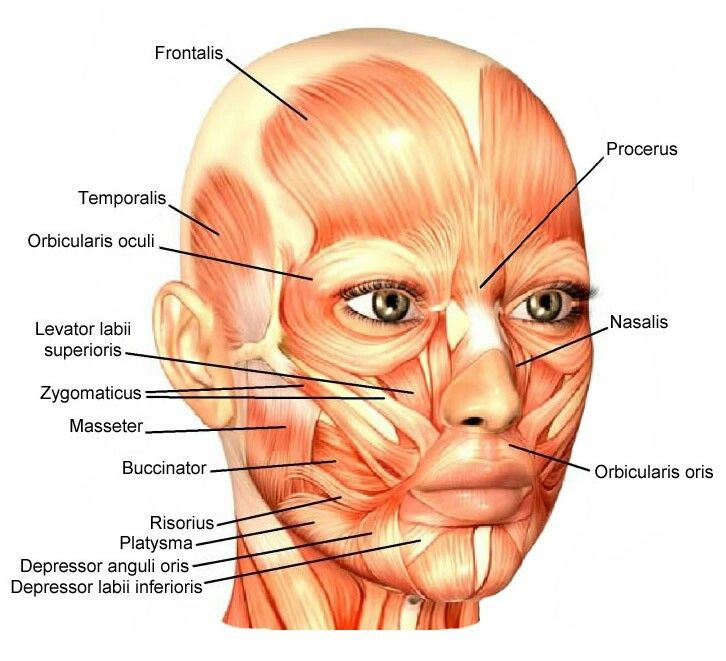
Anatomy. The structure of the nerves of the face
Motor nerves of face muscles originate from the third branch of the trigeminal nerve and branches of the facial nerve. Each of these nerves occurs by combining
numerous vehicles of motor fibers.
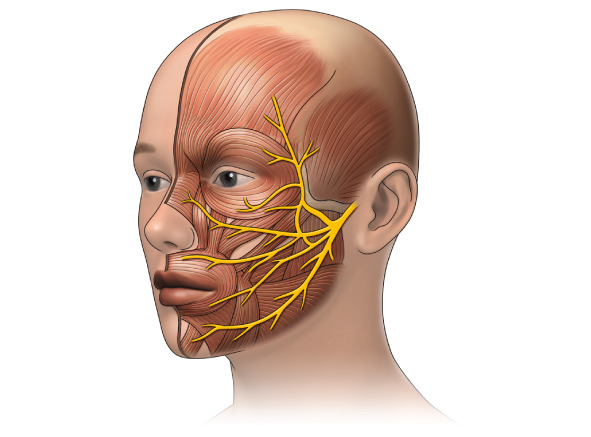
Anatomy. Blood supply face
Just as in the whole body, in the area of the head of Vienna and the artery go there. In many cases, arteries are responsible even for reverse currents in their accompanying veins.
As veins and artery often carry the names of the areas of the body, in which they are located and branched (for example, facial artery, facial vein, topless artery).
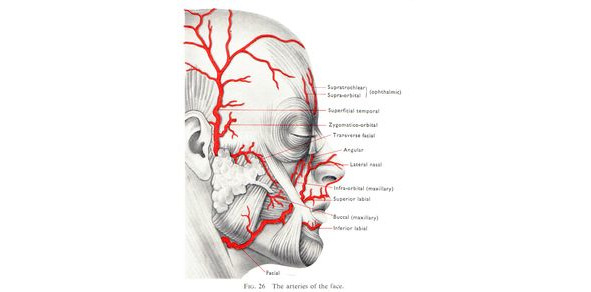
Leather.
Skin structure
The skin is the largest organ of the human body, the mass of which is approximately 16% of the mass of the entire body. Skin surface area — from 1.2 to 2 square meters.
It performs many important tasks. Passive skin functions are protection from cold, heat and irradiation, from pressure, blows and friction. Acid skin mantle formed by a mixture of sebum and sweat having a sour reaction protects the organism from penetration of microbes.
The active functions of the skin are immune protection, resorption of certain substances, the release of sweat, cooling organism and withdrawing by-products of leather activity, education together with silent glands of low-alpine sebum film. Through blood circulation in the skin, metabolism and thermoregulation occurs. The skin is equipped with blood vessels, nerves and sensitive receptors and permeated with skin applements: sweat, sall glands and hair follicles.
The human skin is built of three main layers:
— Epidermis
— Actually leather — Derma
— subcutaneous fiber (hypoderma)
The skin is the largest organ of the human body, its surface area is from 1.2 to 2 square meters.
The epidermis is an outer shell of the skin, built mainly of keratinocytes. Its thickness is about 0.1 mm, with the exception of palms and soles, where it can reach 0.8—1.3 mm.
The epidermis consists of five layers:
— Basal layer
— a layer of spinged cells
— Granular layer
— Brilliant layer
— horny layer
Actually leather — Derma
The thickness of this layer varies from approximately 0.6 to 3 mm. On the centuries, the dermis thinner, on the back or palms — thicker. About 70% of the dermis make up collagen fibers. In addition, it includes elastic fibers and glycosaminoglycans. In this layer, as a rule, implan the pigment.
Subcutaneous fiber (hypoderma)
It consists of loose connective tissue and fat (on the stomach up to 3 cm). Here are larger blood vessels and thicker nerve fibers.
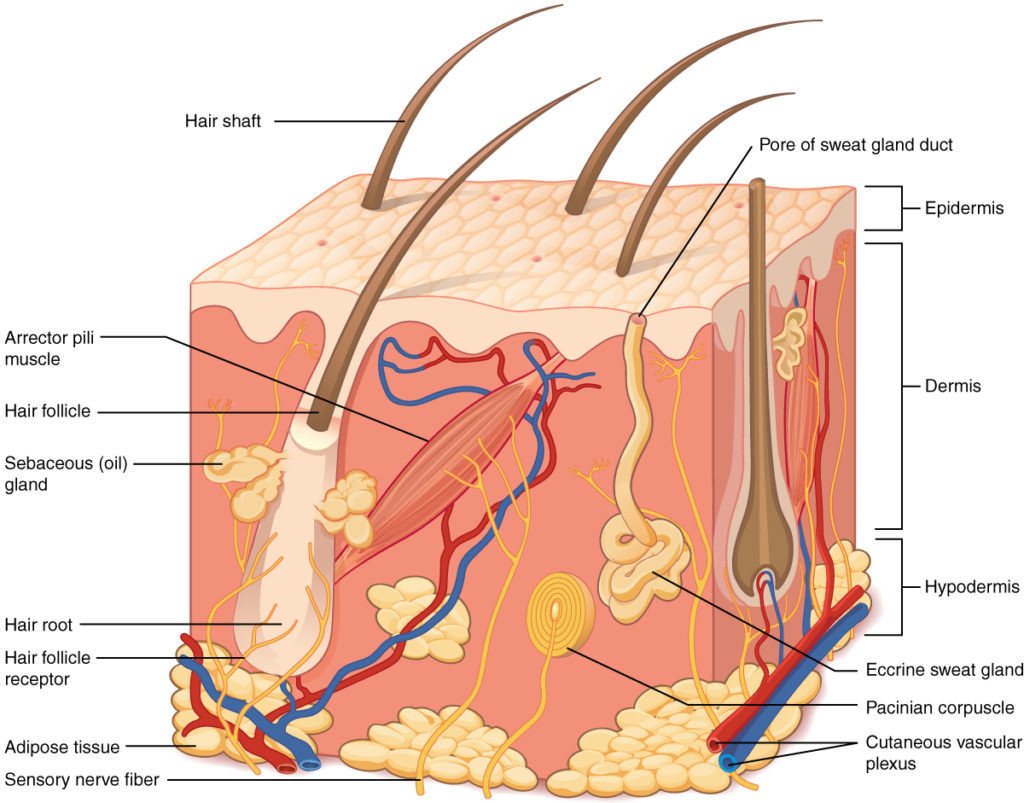
Leather. Sensitive skin receptors
The skin has a temperature sensitivity due to receptors to different sensations, which are located in different layers of skin. Functionally receptors are divided into pressure-sensitive, vibration and touch (mechanoreceptors), temperature change (thermistors) and damage caused by the feeling of pain (nociceptizers).
In structure, receptors can be divided into two groups: free nervous endings and specialized receptors. They are associated with sensitive (afferent) nerves with a spinal and brain and constantly send signals about the state of their environment.
Light pressure and cold are perceived below the surface, end nervous devices that feel warm and strong pressure are more deeply. Receptors are linked by sensitive (afferent) nerves with a spinal and brain and constantly send signals about the state of their environment. Receptors are connected with sensitive (afferent) nerves with spinal and head The brain and constantly send signals about the state of their environment.
Specialized receptors numb five types
— End flasks Krause are located in the dermis, perceive cold
— Taurus pachinas are located deep in the skin and subcutaneous tissue and are sensitive to displacement of the skin at pressure.
— The tent of the ruffini lie in deep layers of the dermis and hypoderma (perceived heat), are branches of flattened nerve fibers.
— Merkel cells are located in the basal layer of the epidermis and perceive constant pressure.
— Maissener Taurus is under the epidermis in the upper layer of the dermis, react to the displacement of the skin when touched.
The epidermis is free nervous endings sensitive to mechanical, thermal, cold and pain irritation. In the deep layers of the skin there are nervous endings of hair follicles. The most sensitive are the lips and fingertips that contain more nerve endings.
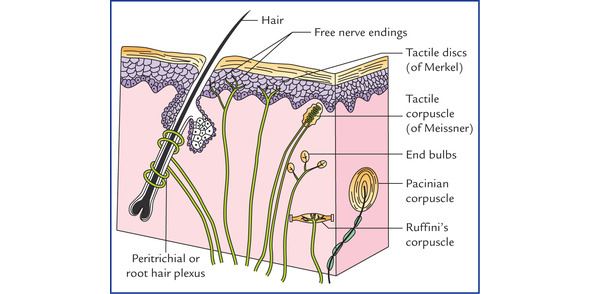
Leather. Color of the skin
The skin color is caused by three pigments: brown melanin, yellow carotene and red hemoglobin blood pigment. Their combinations form an individual complexion. The tone translucent through thin skin determines whether it belongs to a warm or cold type (for details, see the chapter “Definition of skin type”). Individual complexion is due to the combination of all three pigments.
Leather. Derivatives
The skin derivative includes:
— hair that is distributed almost throughout the surface of the skin;
— nails that play a secondary role in our topic;
— sal glands, which are in close proximity to the hair follicles, especially in the areas of sobs on the face, chest and back;
— Potions, which are located in the epidermis, their about two million.
Pathology of the skin
In people who want to make permanent makeup, there are often diseases and changes in skin of exogenous and endogenous origin. Immediately need to emphasize that they are included in the competence of doctors and in the acute stage are not punishable.
For example, skin allergy, eczema, simple herpes — acute states that are subject to PM only after exiting the active phase and treatment with relevant medicines.
In no case cannot be pigmented by sharp skin changes, such as pigment spots, melanoma, papillomas due to the wart virus, fibromes and other skin changes due to the risk of malignant rebirth.
Often small papillomas are found on the edge of the upper century. When pigmarked the clarity edge, you need to work around them, it is not difficult and later will never be noticeable.
In the area of eyebrows, sometimes when pigmented, there are areas of hyperkeratose (excessive orog), in which the skin is thickened. These areas can be treated with a hygienic module, which has a high impact strength. Especially carefully needed to follow the transition of the needle from the boundaries of such a orogue to normal skin, so that the immersion depth of the needle, the uniformity of the color and the thickness of the line has not changed due to the reduction of skin resistance at the hyperacratosis.
Do not pose difficulties with permanent makeup scars on lips and in the area of eyebrows, as a rule, resulting from damage in childhood or at a later time, if only their existence was at least six months.
The exception is the keloid tissue (thickened scar, benignural growth of the connective tissue), which can be changed only by the corresponding surgical treatment.
Strya (stria of pregnant, subcutaneous gaps) in the abdomen, pelvis, chest and thighs caused by a very fast stretching of the skin after an increase in body weight, often annoy their owners. There is an opportunity to hide these ugly scars by pigment by corporal color. Regarding the so-called camouflage pigment, the opinions are diverged. On the one hand, it significantly increases the amount of work and the income of the cosmetologist. For a short time and the client will be pleased with the result. But it is necessary to remember that the dye of the corporal color consists of white dioxide titanium and small additives of the coloring pigment. At titanium dioxide, a small sustainability period, it is unstable in the light. Camouflage pigment is never preserved for a long time, after the collapse of titanium dioxide, the color in most cases will become ugly gray-brown. The acute states of skin diseases are punishable only after treatment with relevant medicines.
Also controversial or, as often spoken, irresponsible, is to carry out the so-called imitation of hair, that is, an optical “seal” of rare hairs at the top of the forehead. They also work with eyebrows, drawing their “hairs to the hairs”.
Since rare hair on the forehead is rare even more, and their border moves back, the pigmented hair additive is shifted forward. Different components of dyes in ultraviolet irradiation differ in stability and, therefore, at the rate of decay. But since in almost every paint for hair, there is some black iron oxide, a cinema-gray pigment residue will always be present in the skin. Pigmenting of acute skin changes (pigment spots, melanomas, papillomas, etc.) can lead to their malignant reincarnation.
Leather. Possible skin reactions on PM
In order to introduce a color pigment into the skin, it is stretched and enter the needle into the top layer. Of course, the skin reacts to these procedures.
How strong is this reaction depends on many factors. Redness and swelling of the processed skin area is a normal phenomenon that usually passes shortly after processing.
The degree of pain is individual and also depends on many reasons. If at this time the client is tense and excited, and before that, perhaps, was something annoyed, the pigmentation will seem more unpleasant to him than at another time. Especially predisposed to pain young women with very sensitive skin, but an experienced specialist who has experience in communicating with people can calm them. A psycho-emotional factor plays an important role here. If the client is careful and he feels trust, his tension will significantly decrease, and he will feel more comfortable.
According to the experience, it is known that if a day before the procedure, the client is intensively sunbathe in a solarium or on the beach, irritation and pain in pigmentation will be stronger.
Possible, but rarely encountered skin reactions with permanent make-up, except for the previously listed normal reactions, are:
Bleeding. Excessive bleeding occurs when the processing is performed at too much depth and with high pressure on the tip of the needle or when there are too thick on the soft tissue of the lips (from the 3rd and above) needle with injective anesthesia. The result in most cases are keloid scars. When working with centuries, blood rarely appears, you only need to continue working with all sorts of precaution. You can stop the blood, wet the damaged place with a cotton swab, imposing a pigment or, if necessary, apply vaseline. Usually experienced masters who work at the domestic depth, when processing the eyelids and eyebrows, blood does not protrude. When performing the lip contour, as practice shows, the opening of the skin during the application of the first line leads to minor bleeding, which can be quickly stopped. With the rustum of lips, an additional surface of the skin opens, and it again causes bleeding.
Lymphostasis, stagnation of lymph. Especially often occurs when the upper century pigment. The edema of the age continues no more than half a day. It may arise the next morning after the procedure after the night in a warm bed, and cooling will be cooling. Recovery occurs through natural healing.
Hematomas, hemorrhage — as a rule, small, inconspicuous “dark specks” in the field of pigmentation caused by minimal subcutaneous bleeding. Recovery also occurs through natural healing.
Conjunctivitis — non-infectious inflammation due to irritation of the age of the eyelid, most often in a weakened form, manifests itself in the form of burning and itching age, as a rule, short-term (one day).
Keloid (keloid scar) — a benign reduction of connective tissue, occurs when deep damage (with too deeply introducing the needle, especially with injecting anesthesia of the lips!). It is flat, swollen or highly convex growth of pale pink or alabastra. Recovery of normal structure practically does not occur.
Allergies — spontaneous short-term reaction, itching, irritation, the appearance of blisters (urticaria), manifestation of an enhanced protective reaction of the body. Clients need to provide first aid: put on a flat surface, cool the forehead, control the breath. This reaction can be avoided if you know the test results for allergies in advance.
Circulation disorders — occur during the procedure, caused by strong emotional tension. Signs are the pallor, a feeling of dizziness, the protrusion of sweat, nausea. It is necessary to put the customer so that the legs are above the chest, calm it, cool the forehead. With proper handling, this state passes within a few minutes.
Leather. Allergy test
If in a preliminary conversation with the client, you learned that it has an increased tendency to allergies or he has an allergic passport, we advise you to spend the test for allergies before work.
Allergic reactions most often include some lip paints that contain inorganic and organic pigments.
The easiest way to spend the test on the skin behind the ear, the thin line applies to the pigment, which is supposed to be used for makeup. Allergic reaction occurs within a few minutes in the form of redness, swelling or other skin reaction. Allergic reactions may occur both to pigment components and anesthesia. First of all, you need to mention the often advancing allergic reactions to Emla ointment. As a result of its use in the field of the eyelids, swelling arises and redness, sometimes last weeks. In the area of lips and eyebrows, it also reaches edema, redness, even to inflammatory reactions, peelings of the lips, painful suppuration. Applying liquid anesthesia on a alcohol-lidocaine basis, you from the very beginning to avoid the risk of such manifestations.
You can avoid the risk of manifestation of many allergic reactions using liquid anesthesia on an alcohol-lidocaine basis.
Leather. Simple herpes
The most dangerous complication after pigmentation of the lips is a flash of lip herpes. It causes a variety of herpes virus in the body, which consists of a protein shell. One day, hitting the body, he remains there for life and makes itself felt when the immune system is weakened (often due to a cold illness) or when sensitive parts of the lips are exposed to strong irritation. Since the “rash” of herpes after pigment can contribute to the “flushing” of the pigment, it is necessary to use anti-hyperpent ointment when exacerbating, and for the prevention of taking antiherpess pills, starting from about a fourth day to the procedure.
Especially successful results can be achieved in prophylactic reception of tablets with high zinc concentration. Vitamin E drugs also contribute to enhancing immune protection. In this case, the reception should also be started four days before the procedure and continue the week after it.
In addition, the herpes outbreak can provoke excessive ultraviolet irradiation after pigmenting, so it is necessary to instruct the client about behavior features in the first eight days after the procedure.
In order to avoid the manifestation of herpes, as a result, the PM should be accurately resorted to prophylactic measures.
Leather. The duration of healing after PM
Permanent makeup is an intervention. Even if it looks great, first it is an open wound, and you need to reckon with it. The micropigamination area must be processed by the appropriate fixer, which is a liquid wounded plaster used after permanent makeup, to protect the skin from the bacteria and dust in the air and the environment. During the short term, the open surface of the skin heals itself by forming a thin crust, which consists of particles of lymph, blood and residual pigment. Its color is much darker than the color of the dye used in pigmentation.
The healing speed differs in different patients depending on the activity of the immune system and the level of metabolism of the body, which most often depends on age. With age, the healing process flows longer, but it should not be afraid. The crust in the eyelids disappears on average through three or five or even eight days, on the lip in three or four days.
It should be borne in mind that permanent makeup, despite the fact that it looks great, first is an open wound.
Leather. Violations of healing after PM
Usually after permanent makeup, healing flows without disorders. When they work in specially equipped and equipped rooms, with a sterile consumable material, a disinfectant apparatus, in disposable gloves and compliance with all the rules of hygiene, the risk of contamination (“Contamination” — from Latis “Contaminatio” — contamination as a result of contact, mixing) is minimal. Violations of wound healing may have external or internal causes. Under external reasons, we understand all the external influences on the skin after pigment. Unfortunately, customers are constantly touched by fingers to just a pigmented wound surface. Also, often, despite all the instructions and cautions, immediately after the procedure apply decorative cosmetics. At the same time, the spores of the bacteria and pathogens of infections can be transferred to the fingers.
Another cause of violations during wound healing is the application of healing creams purchased in a pharmacy. These healing creams “recognize” with such labor entered pigments as foreign bodies and contribute to their conclusion from the body, which can lead to inflammation.
The external causes of violation of the wound healing, as a rule, are applied immediately after PM decorative cosmetics and the use of healing creams purchased at the pharmacy.
Internal causes of violations of wound healing are any diseases or medications that can be from the inside to prevent the healing process.
Once again, I would like to emphasize the importance of pre-concerned anamnesis necessary for preliminary recognition of adversely for the procedure for permanent makeup of factors. Diabetics, persons suffering from hemophilia, persons who take medicines for blood liquefaction or those who have an acute infectious disease should not pass pigment or may be allowed to be admitted to it after consulting the doctor.
Preceding chemotherapy pigmentation can also make healing. In situations where violations of wound healing occur, it is possible to recommend the reception of vitamin preparations with a high zinc content, which is favorable affecting the regeneration processes. In most cases, these disorders disappear and cured within two or three days.
Posseably affect the processes of skin regeneration vitamin preparations with a high content of zinc.
Leather. The ability to transfer pathogens of infection during the procedure PM
When working with open skin, it should always be taken into account the danger of infection. We do not want to inspire the fear of the permanent makeup procedure or even scare away possible customers. On the contrary, we want to draw attention to how it is important to comply with the requirements of hygiene during permanent makeup.
Not sufficiently sterilized or disinfected items can transfer pathogens such infections as AIDS, hepatitis B, C and D.
A clinical study conducted in the South-Western Medical Center of Dallas Texas University showed that 22% of patients infected with hepatitis C were tattooed. Among those who had no tattoos, only 3.5% were infected with hepatitis. These figures vividly indicate how important is the observance of the rules of hygiene and the use of sterile materials. If it is known that the client is infected with hepatitis or AIDS, the master is obliged to resolutely refuse to pigmentation.
The procedures of permanent makeup must be performed in a marry bandage, which protects against drip infections with colds and contamination by cough, tuberculosis and diphtheria.
A compulsory requirement for micropigamation is the use of rubber gloves, disinfection of working materials, equipment and the use of sterile packaged consumables, as well as cleaning all surfaces using appropriate means for disinfection.
The most important rules for permanent makeup is observance of hygiene requirements.
Workstation for permanent makeup
Cabinet for micropigmentation and workplace should be equipped so as to ensure compliance with all the rules of hygiene.
Requirements for the room
— There should be no carpets so that the floor can be disinfected;
— all surfaces (table for the device, apparatus) must be made of material that can be disinfected;
— There should be no living plants (the Earth is the perfect nutrient medium for mushrooms and bacteria);
— All covers and napkins need to be washed at a temperature of 90 degrees.
Requirements for workplace
The optimal organization of the workplace and hygiene is inextricably linked concepts. On the desktop there must be only objects and equipment directly used in the work. It is recommended to handle cotton swabs, cotton wands and other small working items with ultraviolet radiation.
In the workplace for pigment should be:
— a disinfected pigmentation apparatus;
— Needles of the necessary configurations and suitable dumps (or hygienic modules);
— means of disinfection of the skin, means for disinfection of hardware surfaces;
— anesthesia;
— disposable gloves and mask;
— chosen for pigmentation dyes and additive preparations;
— Pigment vessel with stand;
— cotton buds;
— medical cleansing agent;
— cosmetic napkins;
— Naked Magnaya;
— mirror;
— garbage container for used consumables;
— Recycling container for used needles.
The clean and well-organized workplace of the professional immediately gives the client an idea of the qualifications and thoroughness of its owner.
Before starting work, you need to check again if everything is needed on the table. After the gloves are put, nothing else can be torn with their hands and leave the workplace.
After the work, it is necessary to take care that all items concerning gloves (for example, a lamp, if the light was installed) were rubbed with a disinfection tool, since the infection can be transmitted through them.
All used consumables are cotton wands, cotton tampons for cleaning and, of course, the dye cups and gloves must be immediately thrown into the waste container. Stand for a vessel with a dye and a sleeve for the handle at the end of the work should be cleaned with the device for ultrasonic disinfection with the appropriate disinfection solution.
Used needles and dupities must be immediately placed in the needle capacity to avoid accidental damage.
When the client gets up after the procedure, he must see a clean workplace. It is also a sign of professional work.
A sign of professional and qualified work is a clean and well-organized workplace before and after the procedure.
In practice, we often see that after work, the gloves are removed and immediately stick in the pocket of the working robe. With these gloves, which were touched to the patient’s open mouth, then without any remorse will work with the following client. Apparently, the economical “masters” do not even think how many microbes or even pathogens of infectious diseases like hepatitis they can transfer.
You can vouch that no client will want to acquire AIDS or hepatitis in addition to permanent makeup. Another death sin against hygiene is not to postpone the needles immediately after use, but to save them for further work or close the used dye with the lid so that they will use them again. It is difficult to even imagine how bacteria will be multiplied by the client’s skin on the needles and in the dye, by the time of the next work. Think, because I will not touch the used scalpel, clips and needles without sterilization to use any sterilization. Since permanent makeup is also an operation, the same hygiene and disinfection rules must be observed to protect the health of the client.
Permanent makeup is the same surgical operation. Therefore, the rules of hygiene and disinfection should be as strict. — special container with wet cotton disks;
Hygiene and disinfection of the workplace
You must ourselves:
— Before starting work, carry out disinfection of the skin of the hands, and then gloves;
— sterile packaging (needles, modules) unpacking immediately before starting work (and in the client’s eyes) in the appropriate gloves and immediately insert into the handle;
— Never touch the bottle with a dye to a pigment cup or to a hole of the dubs;
— Do not put the used cotton sticks or tampons next to the client;
— It is recommended to wear a gauze bandage, especially with a slight cold;
— Hepatitis vaccination is recommended for your safety.
After the end of work:
— spray and wipe all the surfaces with a disinfectant;
— a disinfectant must be effective against AIDS and hepatitis, pay attention to the expiration date;
— the sleeve sleeves, the stand for a dye vessel immediately after use you need to clean and disinfect with the device for ultrasonic disinfection;
— For ultrasonic disinfection, recommended disinfection means should be used (lysitol-M, Stamopour) in prescribed concentration;
— throw away the vessel with the dye residue;
— used needles postpone separately into the needle container to avoid injury or infection;
— used modules to put vertically, so that the needle is automatically hidden into a loaf;
— Used gloves to throw out after the end of working with each client.
Hygiene and disinfection of the workplace
You must ourselves:
— Before starting work, carry out disinfection of the skin of the hands, and then gloves;
— sterile packaging (needles, modules) unpacking immediately before starting work (and in the client’s eyes) in the appropriate gloves and immediately insert into the handle;
— Never touch the bottle with a dye to a pigment cup or to a hole of the dubs;
— Do not put the used cotton sticks or tampons next to the client;
— It is recommended to wear a gauze bandage, especially with a slight cold;
— Hepatitis vaccination is recommended for your safety.
After the end of work:
— spray and wipe all the surfaces with a disinfectant;
— a disinfectant must be effective against AIDS and hepatitis, pay attention to the expiration date;
— the sleeve sleeves, the stand for a dye vessel immediately after use you need to clean and disinfect with the device for ultrasonic disinfection;
— For ultrasonic disinfection, recommended disinfection means should be used (lysitol-M, Stamopour) in prescribed concentration;
— throw away the vessel with the dye residue;
— used needles postpone separately into the needle container to avoid injury or infection;
— used modules to put vertically, so that the needle is automatically hidden into a loaf;
— Used gloves to throw out after the end of working with each client.
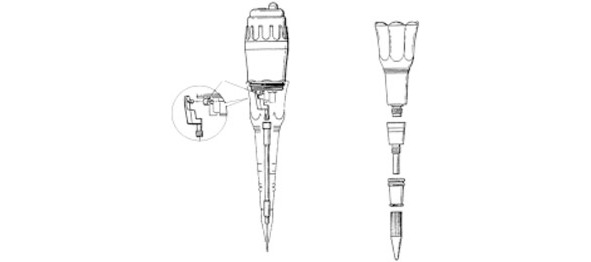
Apply, as a rule, configuration needles from 1 to 8. In the photo you can compare the results of work asia and German needles (with a large thickness needle, the skin is very injured).
The needles are fixed in a one-time holder, which must be changed for each client to eliminate the transfer of hepatitis and AIDS. To secure the needle, a metal collet clamp is used, sometimes used needles curved at the base and fixed in the actuator. Dampers for quenching side oscillations of the needle stroke are missing.
With repeated use, the needle securing is loosened, and vibration with difficulty allows accurate and thin operation.
Many composite parts are made of plastic and wear out very quickly.
Бесплатный фрагмент закончился.
Купите книгу, чтобы продолжить чтение.